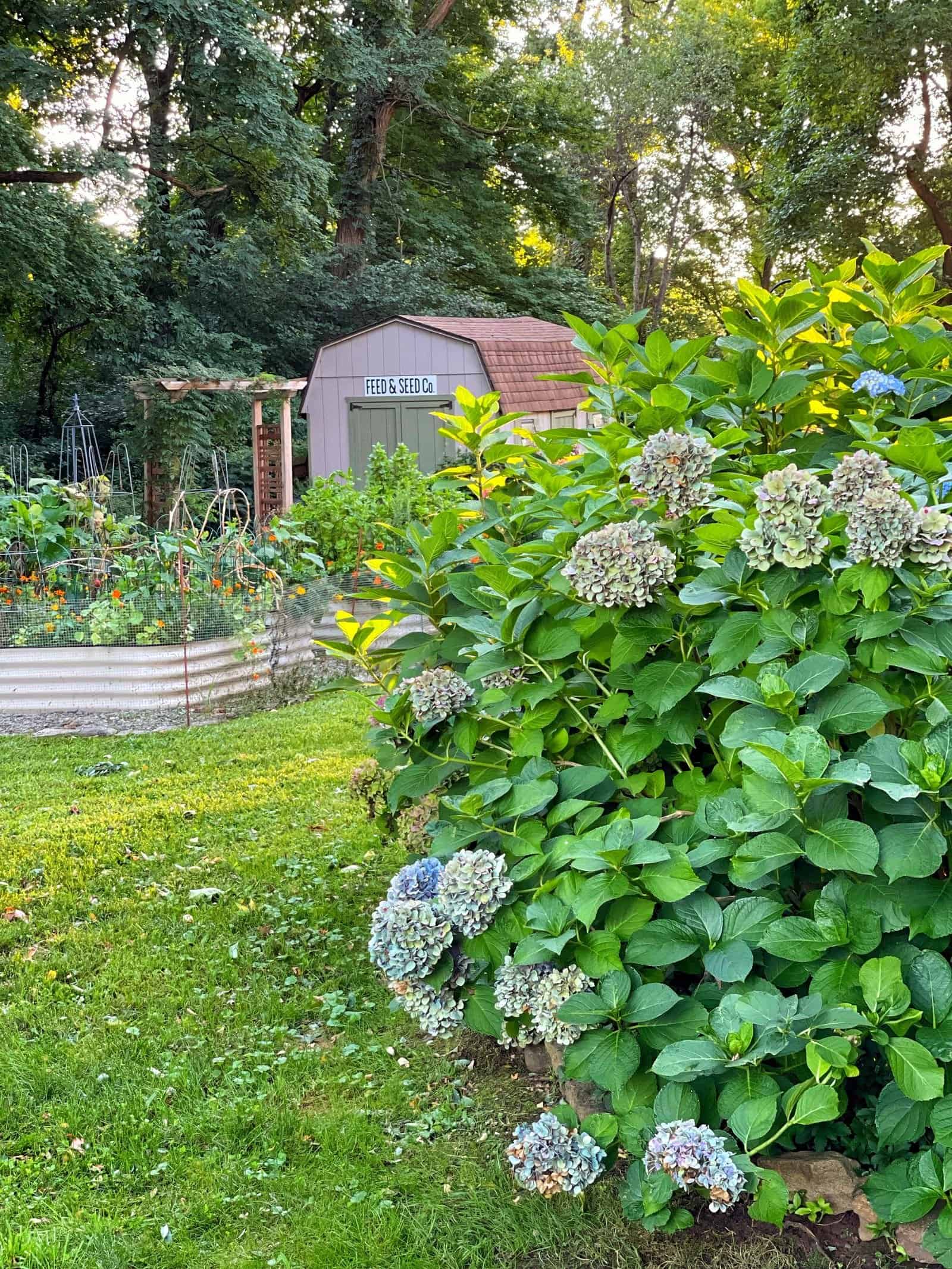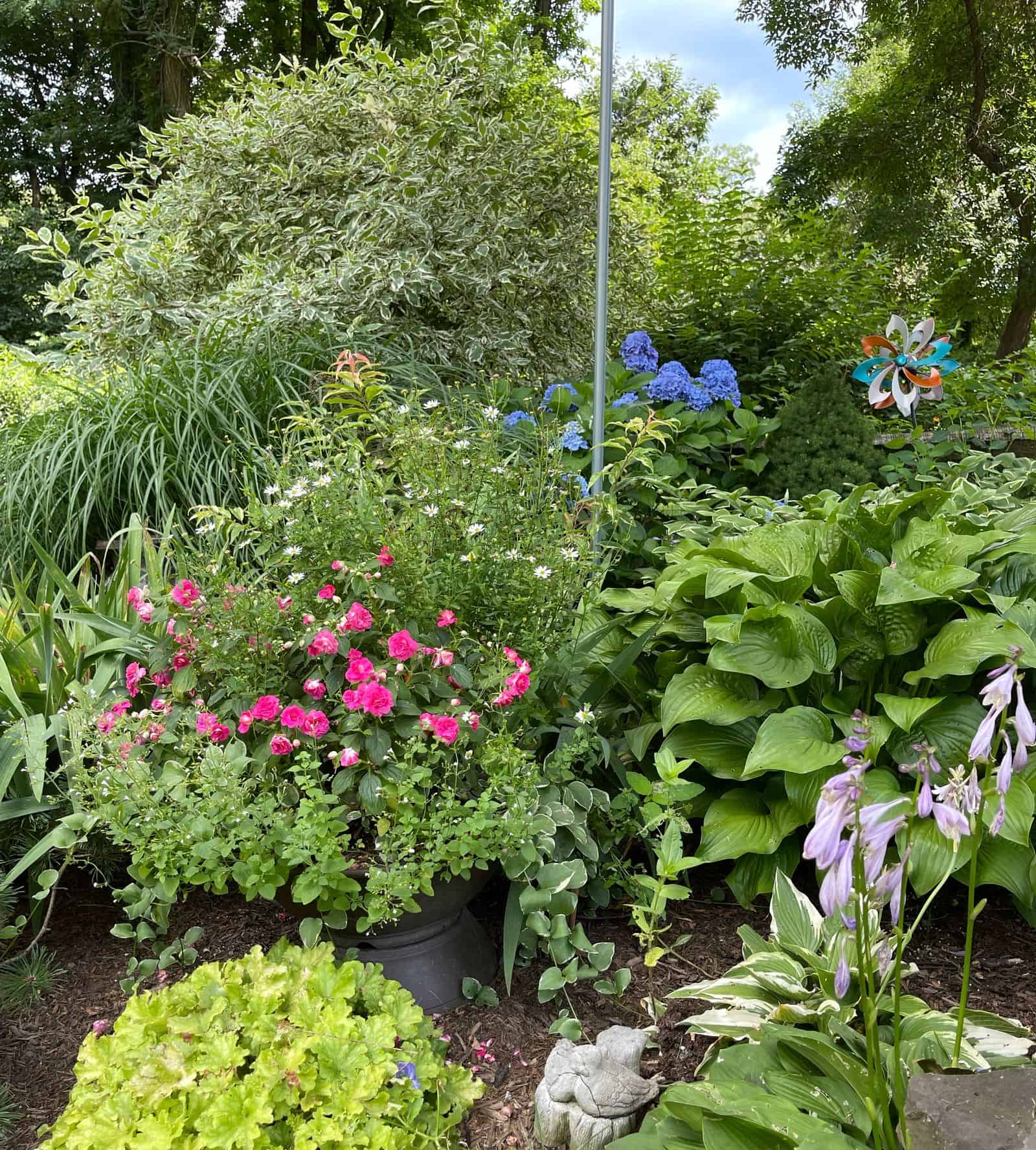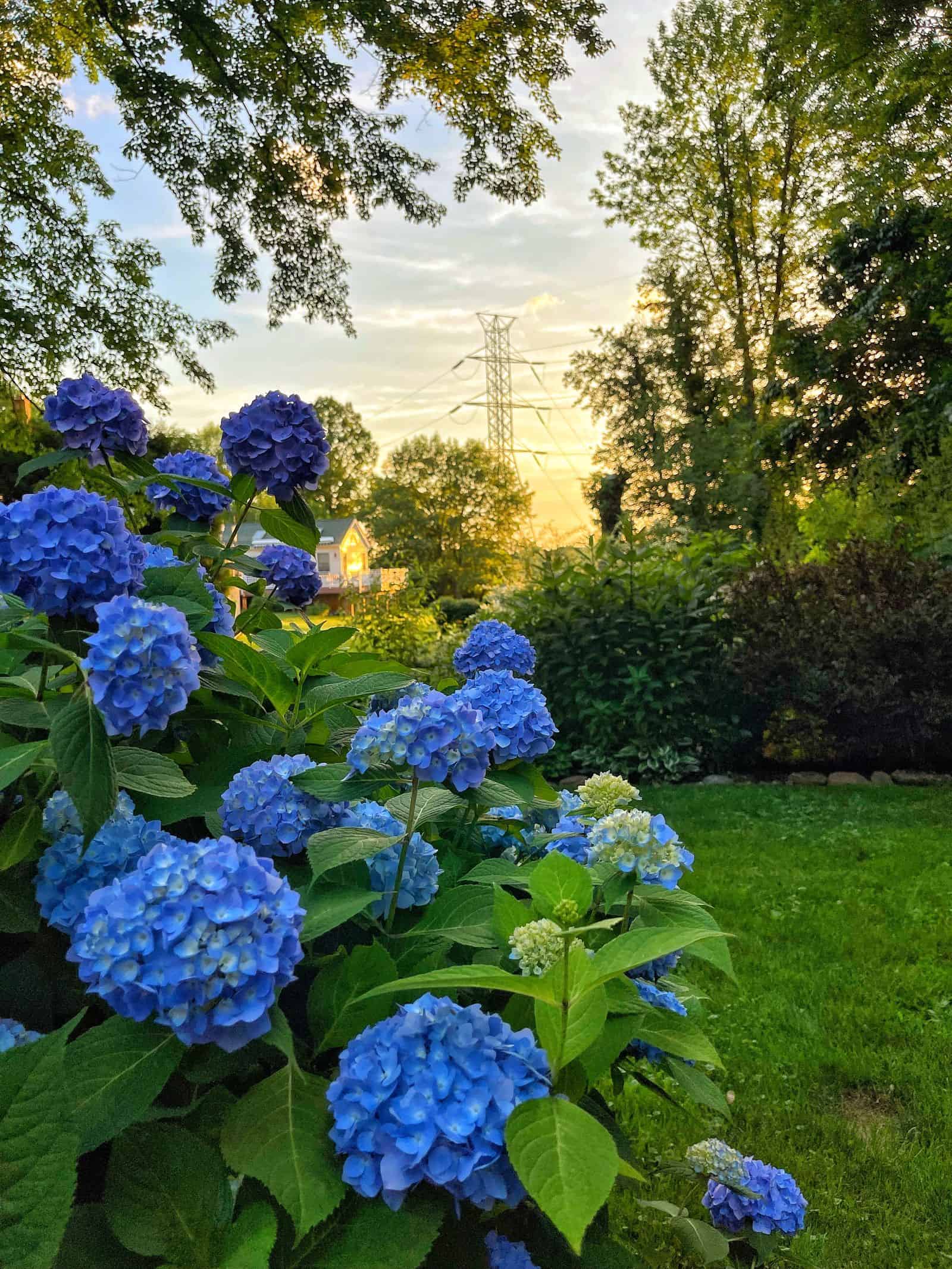Master hydrangea care! Choose the perfect variety, prevent problems, and grow stunning blooms with this complete guide.
Want to transform your garden with vibrant, show-stopping blooms? Hydrangeas are the answer, and this guide will show you how.
Welcome to the world of hydrangeas, where stunning blooms and lush foliage can create a vibrant oasis in your garden. Whether you’re a novice gardener or an experienced green thumb, this comprehensive guide to hydrangea care has something for everyone. From selecting the perfect variety and understanding soil requirements to mastering watering techniques and seasonal pruning, we’ll cover all the essentials to help you grow abundant, beautiful hydrangeas.
Hydrangeas are a very popular plant in the garden, and I receive many questions about them on my blog. I’m a huge fan of growing hydrangeas, as I cultivate several different varieties and have had lots of different experiences with them. For some years, my hydrangeas struggled to bloom. In other years, they bloomed like crazy. Sometimes, hydrangeas take a few years after planting to establish before they even start blooming.
If you want to learn how to start growing hydrangeas, we are covering it all today so you can get the most out of them in your garden and home. Learn hydrangea care basics with these simple tips.
(Posts on stacyling.com may contain affiliate links. Click HERE for full disclosure.)

Hydrangea Care: The Basics
In general, hydrangeas have a USDA hardiness zone of 4-9 depending on the variety you have. Hydrangeas are easy-care flowers with a range of colors that include blues, purples, pinks, whites, and chartreuse. There are lots of different varieties to choose from. Some are bred to rebloom. While others will bloom once and be done until the following season. It’s helpful to know what varieties you have in your landscape because that will drive how you care for them.
- Common Name: Hydrangea
- Plant Type: Shrub
- Hardiness Zone: 4-9
- Light: Full sun to partial shade
- Soil Requirements: Well-drained, rich in organic matter
- Height: 3-10 feet
- Width: 3-10 feet
- Flower Color: White, pink, blue, purple, red
- Foliage Color: Green
- Bloom Time: Summer to fall

Understanding the Different Hydrangea Varieties
Hydrangeas are a diverse group of flowering shrubs, each with unique characteristics and care requirements. Knowing the different types will help you choose the right hydrangea for your garden and provide the best possible care. Here are some of the most popular hydrangea varieties:
Bigleaf Hydrangeas (Hydrangea macrophylla)
- Known for their large, showy blooms that can change color based on soil pH. Acidic soils produce blue flowers, while alkaline soils result in pink or red blooms.
- Two main types: mopheads (round flower clusters) and lacecaps (flat flower clusters with outer sterile florets and inner fertile florets).
- Often require more protection in colder climates.

Panicle Hydrangeas (Hydrangea paniculata)
- Characterized by cone-shaped flower clusters that typically start white and fade to pink or reddish hues.
- Very hardy and adaptable, tolerating colder temperatures and a wider range of soil conditions.
- Blooms on new wood, making pruning less critical.

Oakleaf Hydrangeas (Hydrangea quercifolia)
- Named for their oak-like leaves, which turn beautiful shades of red and purple in the fall.
- Produces cone-shaped white flowers.
- Tolerates drier conditions and is relatively low-maintenance.
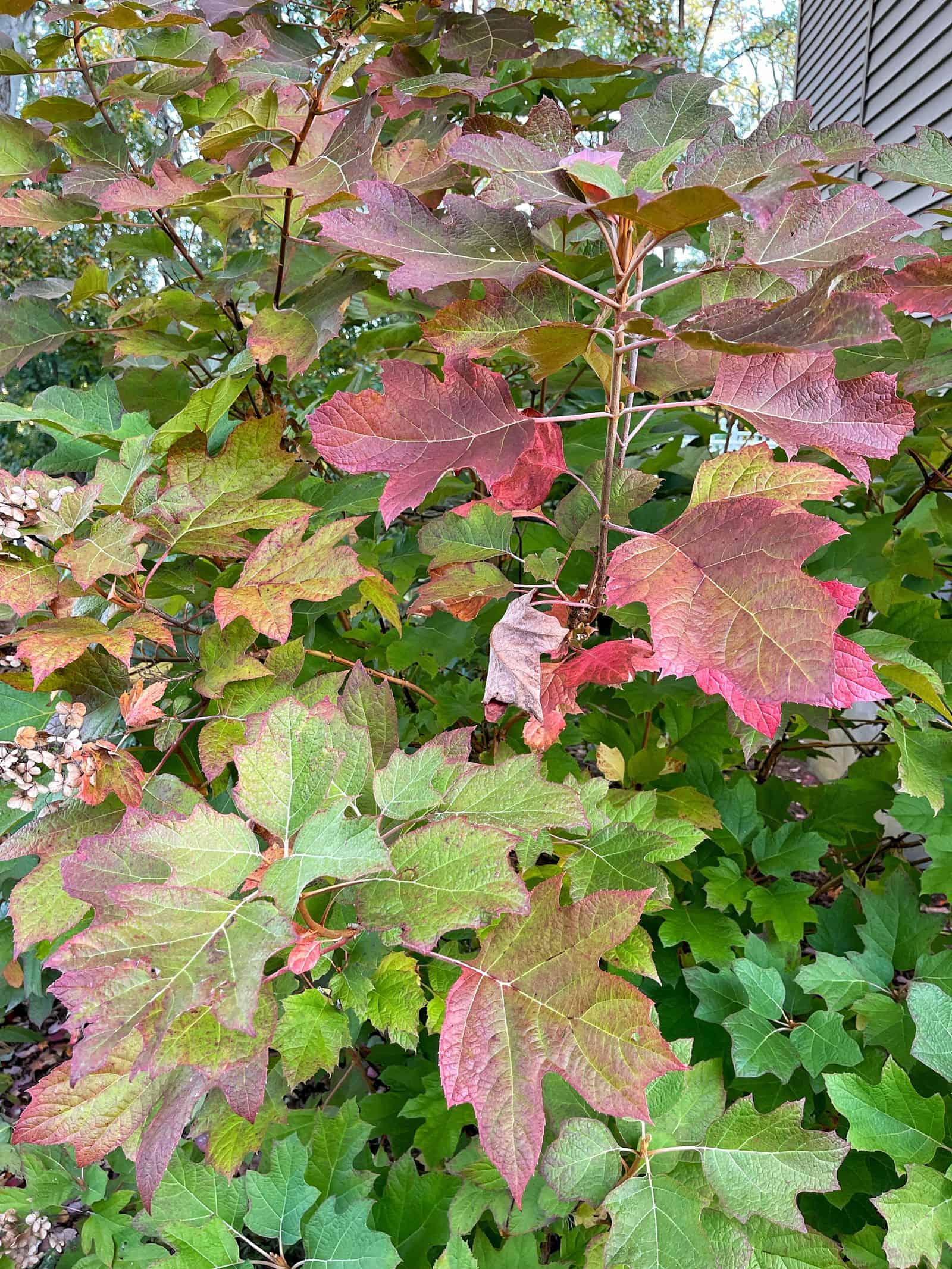
Smooth Hydrangeas (Hydrangea arborescens)
- Native to North America, known for its large, rounded white flower clusters.
- ‘Annabelle’ is a popular cultivar.
- Blooms on new wood and is quite hardy.

Climbing Hydrangeas (Hydrangea anomala subsp. petiolaris)
- A vigorous climbing vine that clings to walls and fences.
- Produces white, lacecap-like flowers.
- Requires sturdy support and can take a few years to establish.
When selecting hydrangeas for your garden, consider your climate, soil type, and desired bloom color and shape. Each variety brings unique beauty and character to the landscape.

Choosing the Perfect Hydrangea for Your Garden
Hydrangeas are an incredibly popular choice for gardens, offering big, beautiful blooms and lush foliage throughout the season. However, with so many varieties available, choosing the right one for your garden can feel overwhelming. To help you navigate the world of hydrangeas, here’s a quick starter guide to consider when making your selection.
Sunlight Needs for Hydrangea Care
Before choosing the right hydrangea for your garden, you’ve got to assess the light conditions you have on the property. Keep in mind that while some varieties can thrive in shadier conditions, you may get fewer flowers.
- Full Sun: Bigleaf hydrangeas (Hydrangea macrophylla) are the classic choice for full sun locations and offer stunning mophead or lacecap blooms in shades of pink, blue, and purple.
- Part Sun: Climbing hydrangeas (Hydrangea anomala petiolaris) thrive in part sun and offer fragrant white blooms in early summer followed by decorative peeling bark in winter.
- Shade: Oakleaf hydrangeas (Hydrangea quercifolia) can flourish in shaded areas and boast unique oak-shaped leaves that turn vibrant shades of red and orange in autumn. I had one that was growing half in sun and half in the shade and the shadier side of the plant had far less blooms.

Consider Bloom Time
If you are limited on growing space, consider when you want your hydrangeas to flower before finalizing your selection.
- Early Summer: Panicle hydrangeas (Hydrangea paniculata) offer long-lasting, cone-shaped blooms in white or pink that start blooming in early summer and last well into fall.
- Mid-Summer: Bigleaf hydrangeas and PeeGee hydrangeas (Hydrangea arborescens) typically bloom in mid-summer and offer a variety of colors and flower shapes.
- Late Summer/Fall: Smooth hydrangeas (Hydrangea arborescens ‘Annabelle’) bloom in late summer and offer large, snowball-like white flowers that add interest to the garden even after the petals fade.

Hydrangea Care: Consider the Overall Size and Shape
The more well-matched the hydrangea variety is to your garden, the less pruning it will require long term to manage the overall size and shape.
- Compact Shrubs: Ideal for smaller gardens or containers, dwarf varieties like Bigleaf hydrangea ‘Mini Penny’ and Panicle hydrangea ‘Little Lime’ offer vibrant blooms without requiring a lot of space.
- Vining Varieties: Climbing hydrangeas are perfect for covering walls, trellises, or fences, adding a touch of elegance and fragrance to your garden.
- Large Shrubs: For a more dramatic statement, Bigleaf hydrangeas like ‘Endless Summer’ can grow to be quite large and offer an abundance of beautiful blooms.
Consider Soil and pH for the Best Hydrangea Care and Blooms
- Acidic Soil: Blue hydrangeas prefer acidic soil with a pH between 5.2 and 5.5.
- Neutral Soil: Most other hydrangeas will thrive in neutral soil with a pH between 6.0 and 7.0.
- Alkaline Soil: You can still grow hydrangeas in alkaline soil, but you may need to add amendments like aluminum sulfate to lower the pH and encourage blue blooms.
Think About What YOU Want
Ultimately, the best hydrangea for your garden is the one you love the most. Consider factors like your desired flower color, bloom time, size, and shape when making your decision. Don’t be afraid to visit your local nursery or reach out to a fellow gardener on socials. Ask for hydrangea care advice from the experts.

Hydrangea Care: Planting Hydrangeas
Have you ever heard the saying location location location? Well, it certainly applies to planting hydrangeas because they have light and soil requirements that are necessary to get the best blooms. Here’s what you need to know.
Where to Plant Hydrangeas
In general, hydrangeas prefer shadier spots where they receive morning sun and afternoon shade. However, some varieties can handle more sunlight and thrive in full sun. So it’s important to read the plant tag to see what kind of light conditions your specific hydrangea variety needs.
When to Plant Hydrangeas
When planting hydrangeas, it’s best to do it in early spring or fall. Avoid planting in the hot summer months because they don’t acclimate as well and require a lot more care than you’ll want to do.
To relocate an established hydrangea, move it during spring or fall. And if I’m getting really specific here, I prefer fall when the temperatures cool down or early spring before the plan leafs out.
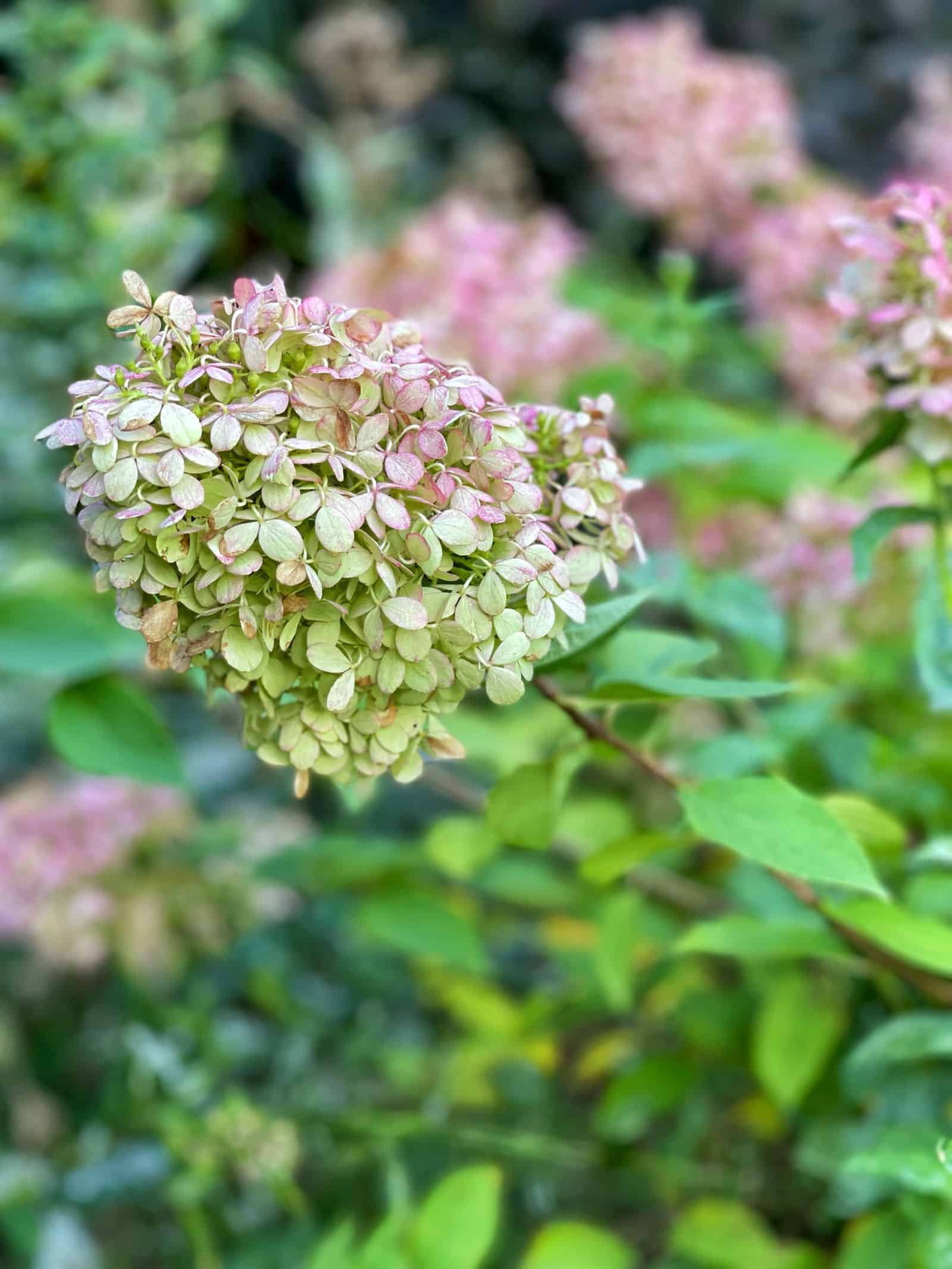
Hydrangea Care: The Soil Matters
Hydrangeas prefer well-draining and rich soil with lots of organic matter like compost and leaf mold. Peat moss and bark are better amendments than animal manure because animal manure is high in nitrogen and can affect flowering. However, well-aged manure is OK to use.
How well your soil drains can greatly affect how your hydrangeas perform. They do not love waterlogged soil. You’ll know it’s getting too much water when the leaves have brown edges or drop. Alternatively, if hydrangeas receive too little water, they will let you know through droopy leaves that revive shortly after watering.
It is a good idea to test your soil before planting so you know what’s in it and how to improve it. You can buy a soil test kit but I advise going through your local cooperative extension because they can really help you drill down on ways to improve your soil for the best hydrangea care.
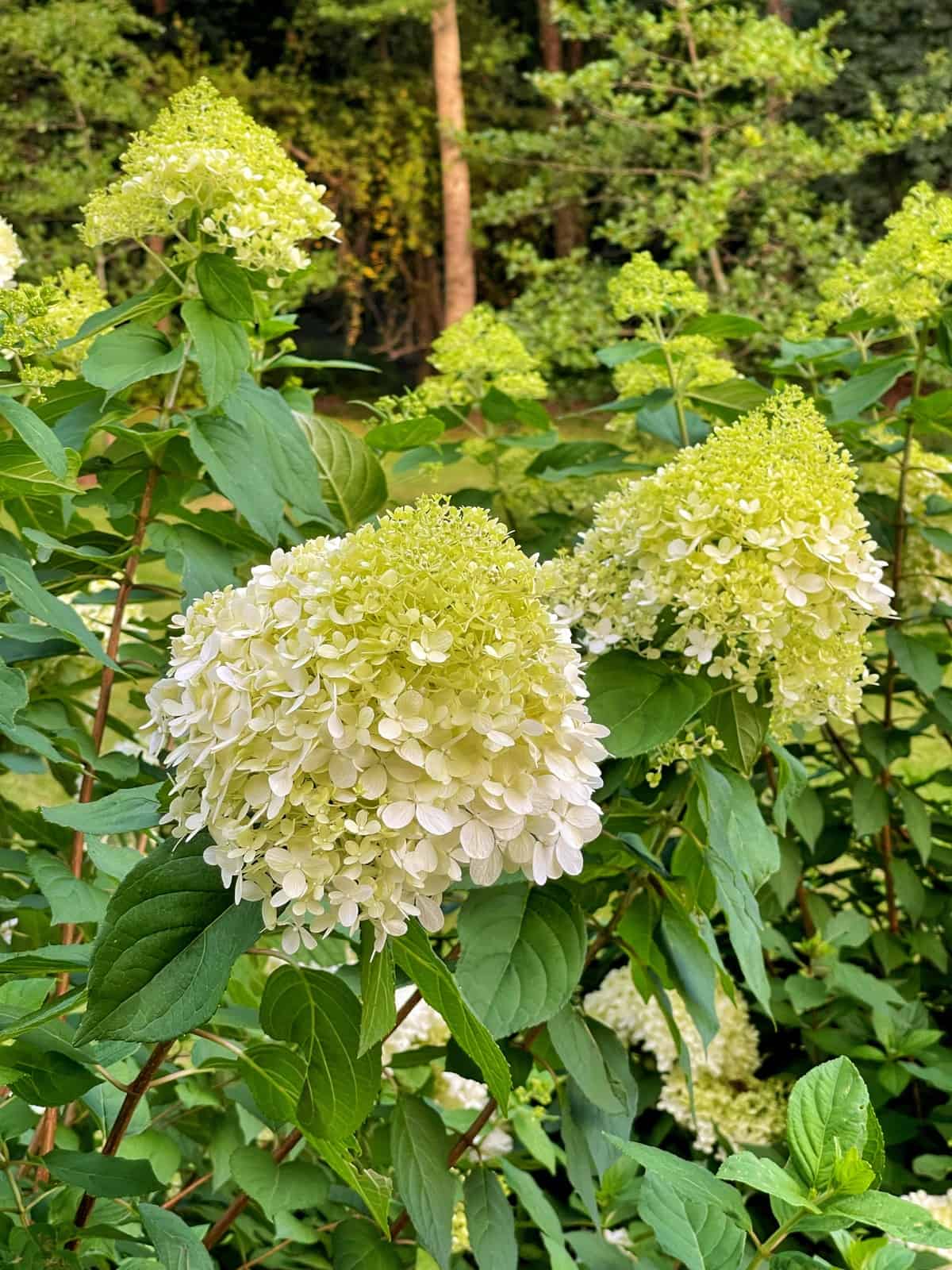
How to Plant a Hydrangea
If you are learning how to plant hydrangeas, it’s pretty easy and straightforward to do. Here’s what you need to know.
- Determine the right planting location by selecting an area with fertile soil and ample room for the shrub to grow. Consider what the overall size will be and understand the light conditions of the spot.
- Dig a hole 2x the size of the root ball.
- Prepare the hole and amend the soil if necessary to improve drainage.
- Remove the plant from the nursery container, loosen the roots, and plant at the same depth as the pot.
- Backfill with garden soil. If the soil needs improvement, backfill with high-quality garden soil and compost.
- Spread organic mulch to help retain moisture and improve the quality of the soil over time.
- It’s also a good idea to add some leaf mold if you have some to help improve the soil quality too.
- Bottom water to thoroughly and keep the plant hydrated but avoid over-saturating the plant so it doesn’t sit in water either.
If you want to make your own compost to use with your hydrangeas, here is a great compost recipe you should use!

Hydrangea Care Maintenance
Watering Hydrangeas
Hydrangeas are thirsty plants and crave consistent moisture, especially during hot, dry periods but don’t love their roots sitting in poorly draining soil. Aim to water deeply at the base of the plant, allowing the water to reach the roots. A good rule of thumb is to water when the top inch of soil feels dry to the touch.
Avoid overhead watering, as this can encourage fungal diseases. Instead, opt for drip irrigation, soaker hose or slow, deep watering to saturate the root zone. Underwatering can result in wilting and stunted growth, while overwatering can lead to root rot. So, finding the sweet spot is key to keeping your hydrangeas happy and healthy.
Keep in mind that your watering practices will look different during the different seasons. Here in my New Jersey, zone 6b garden, I don’t manually water as often as I do during our long hot summers.

Fertilizing Hydrangeas
In general, hydrangeas do not need to be fertilized. This might come as a bit of a shock to you because there are lots of gardeners out there who recommend fertilizing them, but I’m not one of them. Therefore, the best fertilizer for hydrangeas is amending the soil with good-quality organic matter.
If hydrangeas are planted closely to grass and you fertilize your grass, keep an eye on the blooms. Because grass fertilizer is high in nitrogen and affects hydrangea blooms if it’s fed too close to plants. Nitrogen makes plants greener and more lush. So hydrangeas will not flower as much, if at all if, it receives too much nitrogen.

Deadheading Hydrangeas
Deadheading flowers is a key part of hydrangea care that can promote healthier plants, enhance their appearance and produce more abundant blooms. Here’s what you need to know about deadheading your hydrangeas effectively:
When to Deadhead
In general, the timing for deadheading varies depending on the hydrangea type:
- Bigleaf Hydrangeas (Hydrangea macrophylla): Deadhead throughout the blooming season by cutting just below the flower head. Avoid cutting too far down the stem to preserve next year’s buds.
- Panicle Hydrangeas (Hydrangea paniculata) and Smooth Hydrangeas (Hydrangea arborescens): Deadhead after the flowers fade to encourage reblooming. These varieties bloom on new wood, so they can be pruned more aggressively if needed.
- Oakleaf Hydrangeas (Hydrangea quercifolia): Deadhead after the flowers start to fade, but before they set seed. Be careful not to remove buds for the next season.
How to Deadhead Hydrangea Flowers
Look for flowers that have faded or dried out. Use sterilized pruning shears to make clean cuts and prevent the spread of disease. I usually wipe my pruners down with a clorox wipe in between hydrangea plants.
For most varieties, cut about 1/4 inch above the first set of leaves below the spent flower. Ensure you don’t cut too far down the stem, especially for bigleaf hydrangeas. Collect and dispose of the spent flowers and any other plant debris to maintain garden hygiene.

Hydrangea Care: Pruning Hydrangeas
Pruning hydrangeas is a popular question among my readers. Knowing when and how to prune hydrangeas, is important so your plant flowers. Therefore, it’s even more important to know what type of hydrangea you have so you know when to prune it.
Three different pruning categories depend on whether the plant blooms on old or new wood. They are:
- Hydrangea Macrophylla which blooms on old wood
- Hydrangea Arborescens and Hydrangea Paniculata which blooms on new growth
- Everblooming or Endless Summer Hydrangeas which blooms on both old and new wood
Everblooming and Macrophylla Hydrangeas that bloom on old wood should be pruned when flowers start to fade. If cut back between fall and early spring, they won’t flower because the buds were trimmed off.
Hydrangeas that bloom on new growth should be cut back in late winter or early spring. I cut my Hydrangea Paniculata back hard the first seasonable day in early spring and it blooms beautifully every fall. Thus, timing is critical!
If you are not sure what variety you have, reach out to your local cooperative extension or master gardener program and ask them to ID the plant for you. The local cooperative extension and master gardeners are a great resource for home gardeners, so don’t be shy about reaching out.

How to Prune a Hydrangea
Now that we understand when to prune a hydrangea, how do we prune it? Find a budding node and cut it on a 45-degree angle about half an inch to 1” above it. This is where new leaves and blooms will grow.
When you notice completely woody branches on established hydrangeas, cut these branches to the ground to promote new growth at the base. I typically wait until the whole plant is lush and green before cutting these particular branches back so I know they are truly dead. But in general, aside from my hydrangea paniculatas, I don’t prune my hydrangeas much at all and let them be.
When I cut flowers for arrangements or decor, I make the cuts the way I mentioned above. But in general, I leave them alone unless I need to control the overall size. Read more here for more information about pruning.

Growing Hydrangeas in Pots
If you lack garden space or want to add some to your outdoor living spaces, try growing hydrangeas in pots. Hydrangeas grow well in pots. For them to overwinter well, you’ll need to choose a hydrangea variety that is two growing zones higher than your hardiness zone. And make sure you plant it in a container that is all weather so it doesn’t crack or become damaged during the winter.
When grown in pots, hydrangeas will need consistent watering, particularly during the hotter months of the year. I recommend using a drip irrigation system set on a timer to keep them well hydrated and healthy.
While I don’t typically recommend fertilizers for hydrangeas, they will need additional nutrition when grown in pots as the nutrients tend to wash out every time you water.

Hydrangea Care: Common Problems and Solutions
Hydrangeas are relatively easy to care for, but here’s how to address common pests and diseases:
- Powdery Mildew and Blackspot: These fungal diseases thrive in damp, shady conditions. Move affected plants to sunnier areas with better drainage in spring or fall.
- Rust Spots: Overexposure to sun and overhead watering can cause rust spots. Water hydrangeas at the base, ideally in the early morning or late afternoon, or use drip irrigation.
- Sunburn: Too much direct sun can damage hydrangeas. If you see signs of sunburn, relocate the plant to a slightly shadier location during spring or fall.
- Slugs and Snails: These pests can create holes in hydrangea foliage. Use organic slug and snail bait for control.
- Deer Damage: Deer love hydrangeas. Protect plants with deer repellent sprays or other deer-resistant methods. (Personal note: I rely heavily on deer repellent sprays due to my unfenced property.)

How to Change the Hydrangea Flower Color
Hydrangeas are sensitive to pH in the soil. Testing the soil will tell you the pH of your soil. But you can also tell from the color of your hydrangea flowers. Except white flowering varieties, acidic soil conditions cause flowers to be more blue or purple. A favorite of mine.
Note: Avoid trying to change the color of young or newly established plants.
How to Make Hydrangeas Pink
When you see blue or purple flowers, soil pH is generally 6 or lower. If you want to raise the soil pH to get pink flowers, amend the soil with garden lime.
How to Make Hydrangeas Blue
Alternatively, more neutral soils generally produce flowers that are pink or red. In general, when you see pink or red flowers, soil pH is around a 6-7.5 pH. To lower your soil pH, add a soil acidifier like this.
As an aside, I don’t play around with the flower color and don’t really recommend doing it. I prefer my plants to do what they want in the environment that they are in. Because I believe plants do better if we don’t mess with them so much and just leave them be providing the general care they need to thrive.

Hydrangea Care: Propagating Hydrangeas for More Plants
There are a few different methods for propagating hydrangeas. Each work equally well and it’s a matter of preference how you propagate hydrangeas.
The tutorials for each are detailed in the above posts. They are a bit long to detail here, but very simple to do. So give one a shot if you want to propagate hydrangeas and grow more plants for free.
Overwintering Hydrangeas Care
If you are growing hydrangeas that bloom on old wood and you live in a colder climate with harsh winters, it might be a good idea to cozy up your hydrangeas with a layer of burlap or creating a burlap screen to help protect the buds from winter damage.

Drying Hydrangea Flowers
If you want to dry hydrangea flowers for decor, wait until the blooms have a vintage papery look which is typically 6-8 weeks after it starts flowering before cutting them. Fresh flowering hydrangeas do not dry well, so wait until they age a bit before cutting them.
I shared the step-by-step process for drying hydrangeas the easy way here. But in general, cut them when the flowers look vintage, put them in a vase with fresh water that has about an inch of water and don’t refill the vase. Keep it out of direct sunlight and don’t overcrowd the blooms so the hydrangea flowers dry well. That’s it!
If you want a fun fall decorating idea using your hydrangea blooms, I even shared a step-by-step tutorial for making a simple hydrangea wreath where they flowers dry right on the wreath form. If you decide to make it, I’d love to see how it looks!

Fresh Cut Hydrangea Care
If you want to enjoy fresh-cut hydrangea flowers indoors, wait until the flowers are completely open before cutting them. For the best fresh hydrangea care, always cut in the mornings and remove all the leaves from the stem to ensure it retains as much moisture as possible.
If you plan to cut your blooms for a bouquet of hydrangeas, follow there are two ways to prevent hydrangeas from wilting in a vase. So head over to this post if you need to drill down. Oh, and if you hydrangeas already wilted? That same post shares how to revive hydrangeas too.

Hydrangea Care FAQs
Can Hydrangeas Grow Indoors?
If you buy a hydrangea in the greenhouse from a florist or local nursery, they can do OK for a bit but I’ve not found success growing them indoors. While they are wonderful to receive as a gift, I treat them more like fresh cut flowers and don’t have the expectation they’ll last long indoors.
Yes, you can plant them outside, but they are not guaranteed to bloom as they were grown differently than ones you’d find at your local nursery. So if you receive a hydrangea in foil or gift wrap, keep your expectations low when planting them outdoors.

Why Isn’t My Hydrangea Blooming?
There are lots of reasons hydrangeas fail to bloom. Here are a few things to consider so you can fix why your hydrangeas not blooming.
- Florist or Gift Hydrangea
- The Hydrangea Isn’t Planted in the Right Location
- Pruning at the Wrong Time
- Soil
- Too Much Fertilizer
- Recently Planted Hydrangeas
- Hydrangea Not Blooming Because Not Hardy to Climate
To learn more about how to remedy these issues read this article that shares how to fix hydrangeas that did not bloom.
Are Hydrangeas Deer Resistant?
No, hydrangeas are not deer resistant and will need protection from nibblers in your garden. Whether you erect 8 foot fencing or use a deer repellent spray, they will need protection from deer damage. If you don’t protect them, deer will not only eat the flowers but enjoy the foliage too.
Some hydrangea varieties are more deer-resistant than others like climbing hydrangeas and oak leaf hydrangeas, but they are still susceptible to deer damage. So, therefore, I recommend offering some sort of protection to all types of hydrangeas.

Final Thoughts on Hydrangea Care Basics
Caring for hydrangeas can be a rewarding experience, transforming your garden into a vibrant display of color and beauty. By understanding the specific needs of different hydrangea varieties, such as proper planting, watering, soil management, and timely deadheading, you can ensure that your hydrangeas thrive throughout the seasons.
Remember to monitor for pests and diseases, prune appropriately, and provide the necessary nutrients to maintain their health and vigor. Whether you’re a beginner gardener or have years of experience, these tips will help you master hydrangea care and enjoy the stunning blooms these plants offer.
With a bit of attention and care, your hydrangeas will not only enhance your garden’s aesthetic appeal but also provide a sense of accomplishment and joy as you watch them flourish.
For more detailed guidance and expert advice, read these resources from university extensions.
Do you grow hydrangeas? What varieties are you growing? Let’s chat more about it in the comments below.
If you have any questions, comments or suggestions, please let me know in the comments below. I’d love to hear! And feel free to share this post with anyone you think would find it helpful too.
To drill down on more beginner gardening techniques and tips, please read these posts:
- Flower Gardening 101
- Growing a Cut Flower Garden for Beginners
- Container Garden Ideas for Beginners
- How to Start a Vegetable Garden
- Herb Gardening for Beginners
Thank you for visiting the blog today!
Enjoy your day! xo


Want to Learn More About Growing Hydrangeas?
- The Complete Guide to Hydrangea Care and Their Flowers
- How to Divide Hydrangeas
- How to Propagate Hydrangeas
- Why Are My Hydrangeas Not Blooming?
- The Ultimate Guide to Keeping Fresh Cut Hydrangeas From Drooping
- How to Dry a Hydrangea the Easy Way
- Are Hydrangeas Deer Resistant?
- How to Make a Hydrangea Wreath for Free
- How to Prune Hydrangeas







